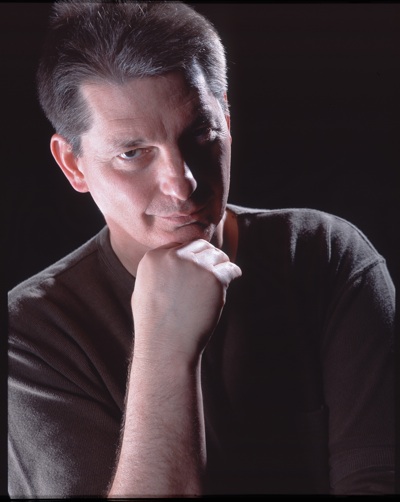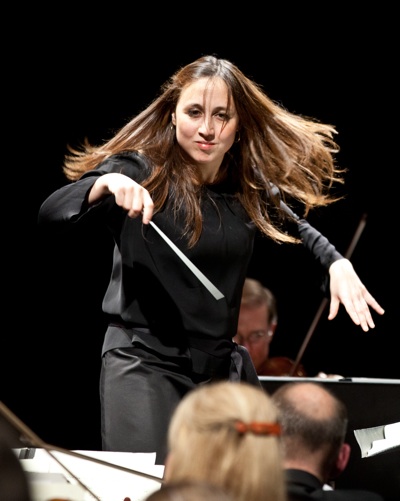Season opens, Symphony hunting for “Innovators.”
What does a fifth Century B.C. numerologist have in common with a contemporary musician and inventor?
Quite a bit, actually.
Along with the theorem that bears his name, Pythagoras was the father of harmonic theory and ancient Greek tuning.
 At the Berkeley Symphony’s opening concert, “The Innovators,” on Thursday Oct. 4, Bay Area composer Paul Dresher attempted to bridge the divide between Pythagoras’ ancient tuning, also known as just intonation, and our modern, well-tempered system, with its nearly even steps.
At the Berkeley Symphony’s opening concert, “The Innovators,” on Thursday Oct. 4, Bay Area composer Paul Dresher attempted to bridge the divide between Pythagoras’ ancient tuning, also known as just intonation, and our modern, well-tempered system, with its nearly even steps.
Dresher has long inhabited the cutting edge of invented instruments, and his 16-foot long electronic quadrachord is a remarkable synthesis of percussion and string. As part of the Berkeley Symphony’s commitment to new work—a commission for every concert—Dresher was invited to write a piece that joins the virtuosity of that quadrachord with an orchestra. The combination was both a delirious adventure and a technician’s headache.
The power of the quadrachord is in its very long strings, allowing us to hear farther up the harmonic series into a terrain where harmony conflicts with the evenly spaced pitches of the rest of the orchestra. Within that conflict and resolution lay Dresher’s magic.
Those two tuning systems also represent radically different views. In Pythagoras’ world of fates and furies, life was divinely ordered and human life was spun and cut to length. However, humans retained the free will to pray, beseech and bargain with their gods.
Those early Ionian numerologists determined the purposes of the gods by understanding the deeper harmonies of nature—all of which have to involve whole numbers, as they are complete waves of vibration. The perfect musical interval of the fifth is the relation of three to two, the fourth is four to three, and the third is five to four. Those who could divine the future expressed that world of waves as whole fractions.
Today, the roles of fate and free will are clouded. Equations of indeterminacy, fractal geometries, string theories, blind social forces and chaos theory have replaced the flights of geese. We have faith in imaginary numbers, and base our tuning on numbers that never resolve, the irrational twelfth root of two. But in seeking that strict spacing, we may have given up the lucidity of those early seers.
Dresher framed his composition as a response to Charles Ives’ The Unanswered Question, which opened the program. That short and seminal work, which inspired a famed series of lectures by Leonard Bernstein, staged a softly shimmering diatonic violin line against atonal trumpet queries and outbursts of winds. Ives’ question, which may have alluded to the nature of direct harmony and modern atonality, was given a breathtaking reading by the Berkeley Symphony, under the direction of Joana Carneiro.
Dresher’s first movement, “Uncommon Ground,” defines those two related divides. As in the Ives, a forest of violins delivered the soft shivering of leaves, and then the quadrachord entered with the sonority of an organ, its bass notes thick with ancient magic—electronically amplified!
The brass interceded, using their upper natural harmonics to reinforce the tuning of the quadrachord. After a moving violin statement by concertmaster Franklyn D’Antonio, Dresher plucked a fast lick that looped into a rhythmic ground. The sharp relief and fast decays of the high plucked notes gave it a “percussive” ambience, like the hollow scooping twang of slapped tabla. Dresher plucked and bowed over that for a driving mix.
He pursued the disjoint tunings in “A Tale of Two Tunings,” with silvered bells and long, looped circles of fifths, then partied down in the final movement as percussion replaced bowed notes. Thick rolling drums and the sharp bird language of wooden blocks joined mallets as Dresher beat on the strings, with a foam block capo to change keys. Then, long-held notes ground across sharper violins and tubular bells. The textures were as unusual as the tuning, with a particularly gorgeous blend of bass pizzicato, tuba and deep quadrachord notes. As the violins evanesced into silence, we became aware of how much of the sound was the quadrachord’s rich vibration.
This piece and instrument may deserve a role in history… if anyone else can play it!
 After intermission we were treated to an earlier innovator. Carneiro was a treat to watch as she coaxed and pummeled her charges in Beethoven’s Symphony No. 7. The symphony, already large by Beethoven’s standards, was further enlarged with 16 talented members of the Young People’s Symphony Orchestra, teens that shared stands with pros. Their combined sound was rounded and loving, if a little less incisive.
After intermission we were treated to an earlier innovator. Carneiro was a treat to watch as she coaxed and pummeled her charges in Beethoven’s Symphony No. 7. The symphony, already large by Beethoven’s standards, was further enlarged with 16 talented members of the Young People’s Symphony Orchestra, teens that shared stands with pros. Their combined sound was rounded and loving, if a little less incisive.
This Beethoven was good-natured, even playful, a far cry from the heroic Third or the grandeur of the Fifth—but it never sacrifices the drama! After a rosy opening came the moving Allegretto, and the orchestra was up on its toes. Carneiro used tiny motions to convey the melancholy passion, then loosened up in the Presto and flung herself into the triumphant finale.
Berkeley Symphony’s next concert, December 6, is a must-see: they leave innovators behind for rebels!
—Adam Broner
Photo top of Paul Dresher, by Andre Costantini; Photo bottom of Joana Carneiro and members of the orcherstra by Dave Weiland.
